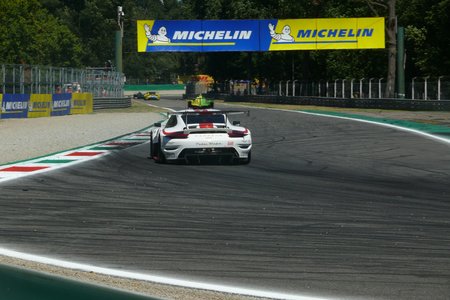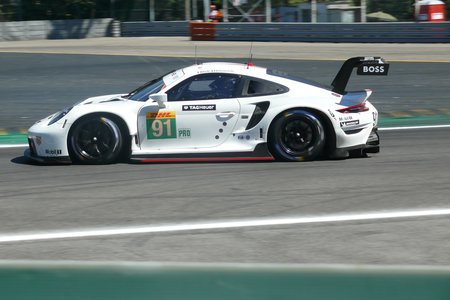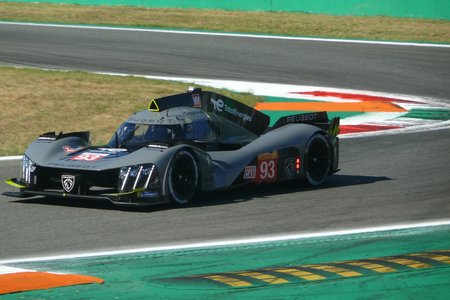



Fourth round of the 2022 World Endurance Championship, held in Monza last weekend, was very promising one, not only because of the debut of new hypercar Peugeots 9X8, excellent weather forecast but also due to largest entry seen in WEC outside Le Mans since 2012 when Spa and Sebring 12 Hours race had more entered cars (6 Hours of Spa had 40 car in the race plus 2 non-starters, while the Sebring even topped best Le Mans entry with 63 starting cars - both were actually first two races of renewed WEC).




Monza was also the first proper international FIA/ACO races visited by the RSC team since 2019, due to various Covid restrictions. In total, it was our only second visit to Monza, following the premiere three years ago. Back then, it was just an ELMS race though. The racing programme was divided into three days, with only single free practice on Friday afternoon, followed by two more practices and qualifying on Saturday and full 6 hour race on Sunday. There was actually no support programme, which might not be liked by spectators, when there were hours of non-track action in between the sessions.




With no more Penske LMP2 Oreca in the field but with two new wing-less Peugeots, the strong 38 field with record 6 hypercar entries (so far really the largest since the class inception though we expect double figures starting next year with arrival of Porsche - set to debut later this year in Bahrain - , Ferrari LMH and at least Cadillac) entered the track for the first time on Friday.




In the heat with over 30 degrees Celsius, the times were not really fast but anyway, it was Glickenhaus LMH that set pace in the first session. And as it appeared over the weekend, it was by far the quickest car in the field, being very close to its maiden victory. On Friday it was followed by lone Alpine (ex-LMP1 grandfathered car - confirmed to switch to rebadged Oreca LMP2 next year before entering the top class again in 2024) and surprisingly one of the Peugeots. The number 93 managed to beat both Toyotas on Friday but the other car number 94 struggled and was classified just ahead of the best GT cars after the entire LMP2 field, which once again consisted of only Orecas :-(.




GTE classification was led by Porsche this time but as it would appear soon, the race here, in the Pro class would be mainly between Ferraris and lone Chevrolet Corvette, which is actually running in its last season as there will be no more Pro class next year - with both Porsche and Ferrari moving up the class.




The first Saturday practice was one of rare successes for Toyota in Monza, winning the session with number 8. Peugeot number 93 improved to second while Glickenhaus was only third, something unusual for them this racing weekend. The Peugeot number 94 was finally sorted out and completed the session 4th right ahead of Alpine and the remaining Toyota. At this moment it looked really promising for the new Peugeots. But as the weekend progressed, it appeared that they neither had the speed, nor the reliability needed to make a success in their first outing.




Porsche was still on top of GTE but generally the 5 Pro entries were very equal, as it is common in this class, thanks to BOP, proven for many years.






Free practice 3 looked great for Peugeot, having both cars in the virtual podium behind the dominant Glickenhaus. Alpine was only sixth, and generally, it did not look quite well for them at this stage of the meeting. But things were about to change soon. In GTE it was the Corvette for the first time at the top, while race dominant Ferraris still waited for their success. It needs to be considered that the practice sessions are not really about setting the pace, but about setting up the cars, trying them for various conditions, especially in the race trim.






The late afternoon was the time for qualifying, the first proper straight forward competition among the new and old cars. First GTE. Ferrari and Corvette appeared to be well matched while Porsches were slightly behind but enough to have no chance of victory in the race unless something unexpected happens. Ferrari-Corvette-Ferrari was the top order. The Pro-Am class battle was also very interesting. Not only because it adds Aston Martins to the traditional Porsche-Ferrari battle but also because one of the Ferraris was driven by a purely ladies lineup.




And this time bronze female driver, Sarah Bovy, made it to the pole position, for the first time in the modern WEC history getting a class Pole Position as a lady. Really great achievement, especially considering she was only 1.4 off pace of the nearest Pro Porsche and she - as a bronze Am driver - is slowest of the squad - but for a Bronze rated driver absolutely great success. The team had just to hope that she would not be moved to the Silver driver classification. The violet Iron Lady Ferrari was followed by the best of Aston Martins and a Porsche, followed by a mix of all three makes, equally split within the field.




The prototype (hmm, hypercar) qualifying started. In LMP2, it was - as usually only about Orecas - but this time it was interesting to see the ARC Bratislava effort on the top of the sheets for most of the session. But in the middle of the qualifying it lied 4th after some times of Hypercars were cancelled due to the track limits - 'favourite' way of some officials to regulate the pure results during the sessions. In the end Beche's time was beaten by one of the Pro Orecas but still it was a great success for the small Slovakian team: Pole Position in the Pro-Am section of LMP2 and second in LMP2 in total. Seventh place overall was also a great success for this team.




It was possible only because of the disaster for Peugeot. Originally struggling car no.94 was now able to set a qualifying time but with no a little improvement compared to free practice it was hopelessly last in the LMH class. The other car, originally more successful no.93 stopped after two laps, not setting a competitive time being destined to the back of the entire grid, including GT cars - that is the problem of current format of qualifying session, something hardly imaginable during the 80s or 70s, but that is life in current racing in general. you have just one short session and if the car breaks early there is no chance of a decent grid position regardless how the car performed the entire weekend. Unfortunately, this practise was applied also for the Le Mans race in recent years, having not a single sports car race with a really proper qualifying format.




The Glickenhaus proved its speed in qualifying and set the pole position being nearly a full second quicker than the second Toyota no.8 and well ahead of the third Alpine. That was the end of the pre-race day programme.




On Saturday before 11 AM, the pit lane was open and entire field started to be gridded. Peugeots were among the first on the grid - originally keeping traditional 2-2-2 grid positions but were soon moved to form the legendary Le Mans grid on the right side of the track. By 11:10 all cars but Porsche no.56 were gridded and all journalists and other guests were allowed to enter the grid. Some great Italian musicians made the atmosphere and it was all prepared for the start at exactly 12 PM, the noon. In the meantime, most of the photographers moved to the first chicane, Primo Variante awaiting the start (see our coming RSC Photo Gallery for the start sequence).




After the pace lap the Glickenhaus immediately went to the lead followed by both Toyotas, the Alpine, Peugeot no.94 and a large field of LMP2 Orecas. Three prototypes started from the back of the grid, including the Peugeot no.93. Alpine soon overtook one of the Toyotas, otherwise positions remained unchanged except for some early pit stops, caused by two early Full Course Yellow.




The Glickenhaus increased its lead for two and half hours until Aston Martin no.33 - thus far in the Pro-Am lead ahead of the Iron Ladies Ferrari, after just having left the pits, spun in the second Variante della Roggia and went airborne ending up in saltos, causing the first and only Safety Car period. By the time the Glickenhaus already lapped fifth running Peugeot and was close to taking on slower Toyota. One minute lead was cannibalized but most importantly, soon after the half of the race, the Turbo failure forced the Glickenhaus to retire.




Then the race became a close battle between both Toyotas and the single Alpine. Peugeot no.94 was also hit by major problems beginning the 4th hour of the race but unlike the sister car no.93, the team managed to finish the race and earn first points for Peugeot to the championship.




In the fifth hour, Toyota no.7 overtook leading Alpine on the main straight but at the end it crossed the line in front of Alpine, which led to unavoidable touch, the results of which was a blown right rear tyre of the Toyota and almost an accident in the Prima Variante. Fortunately the car was kept in the right direction and was saved for the rest of the race. After a tyre change and stop and go penalty, it could continue one lap down, safely third ahead the large field of LMP2 Oreca 07. The rest of the race was about Alpine in the lead, being caught by the second Toyota no.8. The distance between the cars in the final hour was between 2 and 4 seconds for most of the time but pit stops and it was a real sprint to the finish, where Alpine could add its second win this season.




GTE Pro race was even more exciting, having both Ferraris usually in the lead, mixing up with the Corvette, while Porsches broke into them usually just during pit stops, having run longer on fuel. Thus for example, in the middle of the race Porsche no.91 was shown in a 4-second lead ahead of both Ferraris, but having recorded only 3 pit stops, while both Ferraris and the Corvette had already pitted four times.




At the end of the race it looked like a clear victory for the leading Ferrari no.52 but surprisingly Corvette crossed the finish line with just one light shining on its door, showing them as the GTE Pro winner. Well, surprisingly only for those that had not noticed that in the last lap the Ferraris turned to the pits for the final but quite necessary splash-and-dash which gave the Corvette unexpected win. The last ever in a GTE Pro race held in Europe since the class is discontinued from the next season due to lack of interest but Corvette ahead of both Ferraris. By the Ferrari number 51 had to pit a few laps before the end of the race. Sometimes saving a little fuel anytime during the race might be in the end quite crucial, as it appeared this time.




The amateur portion of the GTE group had Iron Dames in the last into the fifth hour, after the accident of the main competitor Aston Martin no.22. But then Proton Porsche no.77 started to prevail and in the end they kept the ladies once again away from the victory in a WEC race. Maybe next time for ladies. They would really deserve a class WEC win for their performance.




Alpine still leads in the World Championship for Drivers while Toyota keeps its lead among manufacturers, most notably due to the fact that they race two cars and partially also because of their success in Le Mans 24 hours, the race with double points. In GTE, despite the results in Monza, Porsche is at the top ahead of Ferrari. Chevrolet with a single-car entry is desperately behind those two.









